Muzaffarabad – Sea of Tents
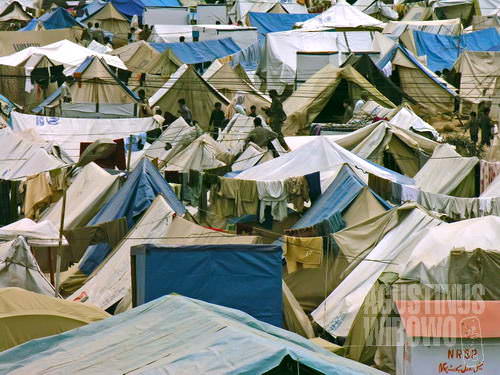
Sea of tents
March 4, 2006
The city of Muzaffarabad, the capital of Azad Jammu and Kashmir, sprawls along two important rivers in Pakistan, Niilam and Jhelam. The two rivers meet in the heart of the city, where the economic activities of the city concentrated. The main road stretched from the north through Chella Bandi area until the ‘Secretariat’ area, of total 4 kms of length. Muzaffarabad is hilly city, the roads are all ‘uupar niche’ (up and down), with several steep cliffs (many were collapsed due to the earthquake 5 months earlier) and ladder provided to pedestratians to up the hill.
Was the main landmark and tourist attraction of the city, the historical Red Fort or Lal Qila is now a bunch of red stones. The remains of the fort, walls now not more than 2 metres tall, are still standing on the top of small hill near Chella Bandi. The shops and houses are also still showing the scars of disasters, with orphaned children beggar sleeping on the street, exhausted of waiting alms from the pedestrians. The shop owners are apparently going back to their shops, despite the risk that the shops may collapse at any single possible second. Open market is also common, where the businessmen without shop buildings offer their stuff on the pedestrian paths. In other parts of the cities, re-building is everywhere. Workers from PWD (Public Work Department) are busy in rebuilding the government and public service facilities. Some others are busy in painting and putting the bricks of hotels or new homes. The life must go on. And it has been started.
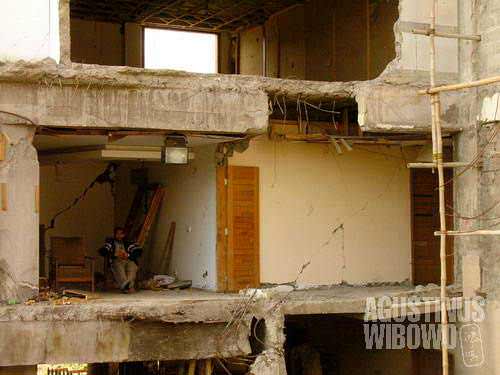
The remnants of once a renowned hotel, Neelum Valley Hotel
Not far from there is the rubble of the collapsed Neelum Valley Hotel. The earthquake had thrown the whole building to the river. The owner was a Minister AJK Government Mrs. Shireen Waheed and Mr Khan Abdul Waheed Khan, was killed with her 14 family members in 8th October earthquake. From the locals I have heard that one of the children ceased the tragedy as he was studying in UK. Now this poor guy had to live alone.
Meanwhile, in southern part of the town, up the hill from the Sectretariat, there is one among the biggest refugees’ camps in the area. Norhol, was the third biggest stadium in Pakistan, was converted by intertanional relief teams as a huge refugees’ camp. The tents, mostly marked with UNHCR or ILO emblem, were standing next to another, crowded, and unorganized, giving the image of a sea of tents, with some ladies with colourful clothes passing between the small path. The life here is not easy, Muhammad Nassir – a refugee, said. He lives in a tent with his wife, his two brothers, and his baby. He was among the lucky ones who didn’t lose any family members in the disaster, but he was among the unlucky ones who lost all properties. Now nothing left, but this tent, some daily equipment, and difficult life. Zindagi (life) o zindagi, Allah is indeed the malik (king), sighed him.

The streets of Muzaffarabad
Nassir, the man of 27 years old, said that except the tent and blanket, there was nothing more given by the government. When I asked until when the people would stay in the tents in Norhol, he said nobody knows. Government didn’t promise anything to them, nor providing shelter homes. The daily food has to be earned by him self, as there is no food or medication from the government. No NGO working for the refugees in Norhol, and the government had given deadlines to most NGOs until the end of March or April, and after that the life of the refugees is completely under the hand of the Pakistan government and some international organizations like UNHCR and ILO.
‘Our government is poor,’ said Nassir, ‘we can’t rely on them for our life.’ Mohammad Nassir is working for an NGO as a security guard, from where he earns 5,000 Rupees per month to support his little family.
Despite the facts of living in tents, without any support and idea when this kind of life would finish, his family was filled by confidence. No tears in that tiny tent (which serves as well as kitchen, dining room, guest room, and bed room), except from the baby who was afraid of seeing a stranger in the small tent or when the aftershocks came. And despite the hardship of his life, he cannot hide his Muslim distinctive hospitability, of offering guests tea and meal. I refused, but he insisted to feed me that day. And our discussion continued.
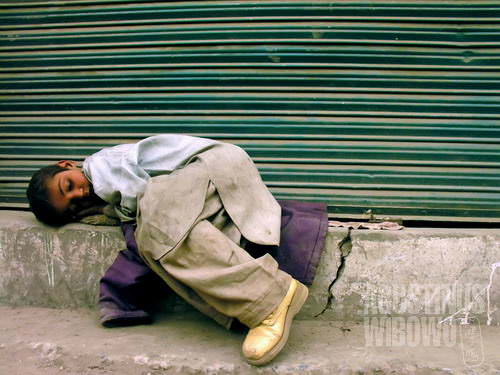
Struggling from the rubbles
About the future of Kashmir, Nassir was more dirrective, that Kashmir should be independent both from Pakistan and India. He blamed the Pakistani government of the policies, that the country regards the land of Kashmir is more important then the people. Pakistan was refusing international aid at that time, saying that they were self-sufficient, just to prevent international spies come to Kashmir. Self-sufficient? The people in tents are still hungry until now. Some refugees were still crying to get shelter homes, looking for NGOs here and there, proving to the organizations how poor they are, begging for food on the street, or getting mental disease of being unable to overcome the life burden. Kashmir, said Nassir, provided the life for the whole Pakistan. River Niilam (Neelum) and Jhelam (Jhelum) give Punjab the water and electricity. ‘See when we are independent, we will block the rivers and Pakistan and India would have to pay for the energy,’ said him day-dreaming.
Life is difficult, but the friendliness and hospitality, still filled the atmosphere in this newly founded slum area. Children were busy playing cricket, while some older men were trying to attract my attention to be photographed. Jalal-ud-din, a man of 36, with a handicapped daughter, offered me a tea in his tent. His tent is even smaller than that of Nassir. His daughter lost one of her legs because of the earthquake. He allowed me to photographe the daughter, but his brother said it was un-Islamic, and forced to daughter to hide from my sight. Photographing woman in this Islamic Republic is one of the thoughest tasks in the world. Jalal-ud-din had quite broad knowledge, even about Aceh and Indonesia. Boasting that he had been serving in Aceh on the behalf of Pakistan government (even I didn’t quite believe him about this as some of his knowledge is contradictive) he told me that Kashmir would recover faster than Aceh. But until when the life in tents would continue, he didn’t know. He said that that Pakistani government gave money 275,000 Rupees to each family (but this information I only heard from him, nobody else told me the story) to get food and shelter homes. If the information was correct, I also questioned why they were still living in tents, while the monthly rent of room in Muzaffarabad city was not expensive either (the rent room for our NGO office is merely 1200 Rs per month; electricity, water, and telephone are free of charge). He didn’t argue me.

Used to be a busy bazaar
Leaving Norhol and walking pass through a mazhar (mausoleum) of a holy man in Secretariat area. The people said that during the earthquake, people were praying inside the mazhar. The holy man was so holy and blessed by God, that people inside the mazhar didn’t feel anything when God rocked the area, and they were surprised when they left the mazhar that their town has turned to be rumbles. The mazhar was standing firm, not even single scratch. Nearby is a madrassah, where young boys and girls were studying religion. They were studying outside the building, as most people do know. As it was said that there was no co-education (where boys and girls study together in schools) in Kashmir, for madrassah the case is probably different.
Mohammad Soaib, a guy of 20 years old whom I met in a Suzuki I hitch-hiked to take me back to Chella Bandi, offered me a tour to the Turkish refugees’ camp in Chella. He only speaks Urdu, and he was surprised that I could speak Urdu also, after his anxiety with his limited English. The Turkish camp in Chella is another contrast of the one of Norhol. There are some armed guards on the front gate, and no unauthorized entry is allowed. The caretaker asked for my permit. I said no. He said I should get one. I said I would leave then. But he then asked about my country of origin, and what my purpose was. He noted my NGO name and then accompanied me to see around. It was a guided tour.

Turkish-built camp
The camp, as expected, was donated by the Turkish. There were only some 5 or 6 Turkish people in the camp at the moment; I met two of them, and none speaking English. The Pakistani caretaker spoke very good English though. First he showed me the almost completed hospital, constracted by the Turkish. The deadline for the inauguration of the hospital would be 26th of thi month, and the Prime Minister of Azad Kashmir would come, he said. There were no doors and windows of the spacious building though. The pills and other medications supplied to the whole city were placed in a tent. I asked whether the stuff wouldn’t be damaged due to the temperature, he said that until April it would be no problem at all. But after April, all of these medications would be moved to an AC-room.
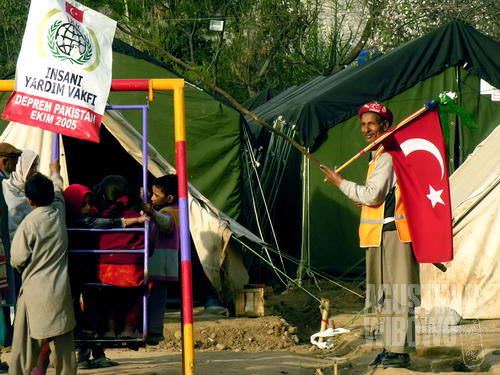
“I love Turkey,” he says
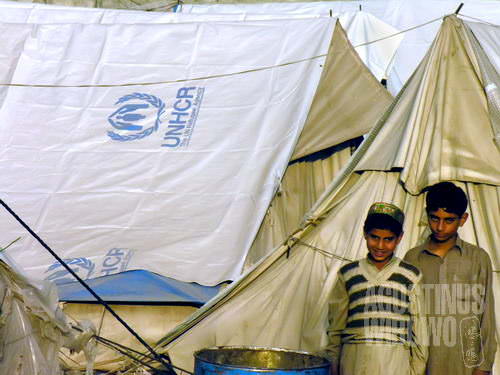
Insaniat Yardim Vakfi camp
The Turkish camp is an organized city of tents. The organizations who work in this area are IHH (Insani H… H…, Turkish language) and Khubaib organization. The banners around the town that they welcomed zaqat donation from America were from them also. There were more than 1200 people living in this camp at this moment. The refugees’ tents are built in very organized lines, with some different blocks and districts. There were kitchen for the women to cook, so they won’t cook inside the tents. There were around 36 stoves in the kitchen so 36 women may cook simultaneously. There was even a time-table to arrange the cooking time. Nearby are classroom tents, for children to study secular and religious knowledge. The Turkish financed the education, but the teachers were all Pakistani. For women who want to sew, there was even a sewing room with a sewing machine and a big TV set. Clothes washing could be done easily with the help of washing machines, and the drainage system was made along the tents to guarantee the hygiene and sanitation of the whole camp. The huge toilet rooms were also equipped by clean and modern facilities. And there was also a modern children playground. It was indeed a very luxurious refugees’ camp I’ve ever seen in my life. Turkey is not a rich country either, but their dedication in helping other Muslim countries in disasters should be respected. The caretaker said that he had never seen Indonesian teams, neither in Muzaffarabad or Manshera. If I was not mistaken, there was also news in Indonesia that our country sent teams to the earthquake affected area, but even the embassy in Islamabad couldn’t tell me the location. Being an Indonesian, I felt ashamed.
Love toward Turkey, as a dropped angel from the sky, can be felt from the eyes of the Kashmiris. A mad man (being mad prior to the disaster) was carrying a very huge Turkish flag, wearing a cap full of Turkish emblems and pins, was following us and smiled all the time. He wanted me to include the Turkish flag in all of my photos.

The Turks also educate the children
Nearby is another camp of Turkish Red-Crescent. Here the red and white coloured, same shaped and sized shelter homes were built in organized lines and blocks. They even gave the road names, like Friendship Street, Confidence Avenue, Dignity Lane, etc. The shelter homes were equipped with new furnitures, clean and modern. The water was provided in the main boulevard, that children could drink directly and collect the water for the family. But not all were lucky living in the permanent shelter homes. Some were still living in tents. Until when they would be here? The caretaker said that the Pakistani government gave the deadline that all refugees should leave the tents by the end of this month, 31st March. To where? Nobody knows. The government are not prepared with shelter homes either. The caretaker wished that they in the bureaucracy would extend the dateline for these helpless people.
From Norhol to the Turkish camp, from the poorest life of the tent slum to the modern technologized shelter homes, the spectrum of life of the refugees in Islamabad sprawls. But all have the same question about their future. And the government can not answer (yet).

Leave a comment